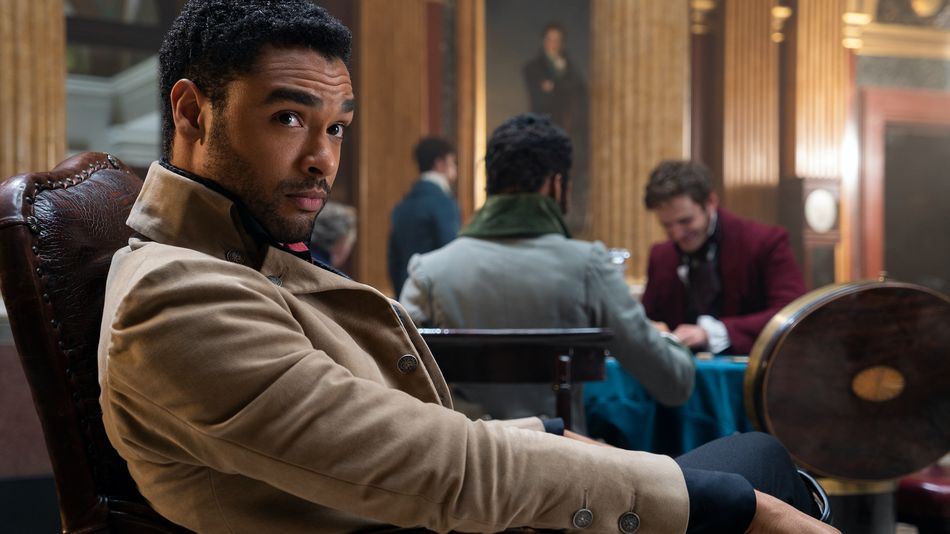
Image: LIAM DANIEL/NETFLIX
The appeal of historical romance stems from the genre’s hallmarks of sexual repression, codified social strata, and great gowns, beautiful gowns. They are an imagined remembrance of a time when people lived constricted by conduct and found true love in the tension between stiff-backed politeness and concealed desire. That tension is all well and good, but the best period romances also remind its viewers of something else: that old timey people were horny as hell.
Bridgerton is the first show created from Netflix’s partnership with Shonda Rimes’ Shondaland, and it is outrageously, tumultuously horny. This is not the genteel horny of Downton Abbey, which downplayed the potency of its leading lady’s seemingly lethal vagina with nary a sex scene, nor is it the gross horny of The Tudors, which turned sex into something Henry VIII did to women before killing them. It is today horny, a Regency-era reminder that the only reason 19th century dudes didn’t send dick pics was a lack of handheld camera technology.
Based on Julia Quinn’s bestselling novels, Bridgerton is a multicultural period romance with modern sensibilities and all the fancy trimmings a historical drama fan could ask for. The balls, the dresses, the carriages, the tiaras — they’re all there. The series follows the wealthy Bridgerton family in their quest to garner advantageous matches in the cutthroat London season while their every move and potential scandal is chronicled by the mysterious newspaper columnist Lady Whistledown (voiced by Julie Andrews).
The first half of the season focuses on the prospects of Daphne Bridgerton (Phoebe Dynevor), the eldest girl and only “out” debutante in the family. Her flirtations with the Duke of Hastings (Regé-Jean Page) and an Austrian Prince (Freddie Stroma) carry most of the straightforward romance in the season while her siblings and other side characters form the background chatter in what appears to be her story. However, a mid-season shift in priorities brings Daphne’s siblings and those alleged side characters into the forefront of the story, which makes the second half feel more like a four-episode ramp up to an expected second season than a natural continuation of the first.
Lots of shows have a twist that changes their plots mid-season, but Bridgerton‘s change is awkward because many of the characters the audience is meant to pay attention to in that second half are not all that compelling. Daphne’s brother Anthony (Jonathan Bailey) is annoying and selfish, which makes his affair with an opera singer (Sabrina Bartlett) anticlimactic. Her other brother Colin’s (Luke Newton) late-season romance falls flat, and the third brother Benedict (Luke Thompson) either wants to paint or is bisexual — the fact that it’s hard to tell speaks to how little his character matters in the end.
“Bridgerton” also does away with the boring lack of representation of most period dramas by ignoring the idea that historical shows must hew to the assumed racial makeup of the imagined past.
On the other hand, Daphne’s headstrong sister Eloise (Claudia Jessie) has a sweet, proto-feminist connection with Penelope Featherington (Nicole Coughlan), and if next season is about those two tearing up the town, the show must absolutely go on.
Bridgerton also does away with the boring lack of representation of most period dramas by ignoring the idea that historical shows must hew to the assumed racial makeup of the imagined past. Bridgerton‘s Queen of England is a Black, gossip-obsessed doyenne, and her ladies include women of color; the Duke of Hastings is played by a Zimbabwean-British actor, and the various families of le bon ton are multiracial as well. There’s a hand waving, in-universe “reason” for the diversity, but the excellent casting suggests that the creators of Bridgerton were more interested in a “why not” approach to adding some color to Regency London than in justifying their choices with a particular reason why.
Some of Bridgerton‘s plot lines allude towards a purposeful message around sexism and power, but the show isn’t smart enough to pull those off. It delights too much in a good marriage and prefers squishing its social problems under the heel of some character or another’s bejeweled slippers to letting its morals linger. Lucky for Bridgerton, intense social analysis was never going to be a selling point of the show, and enjoying the dazzle of Regency fashion, string quartet covers of modern pop songs, and the occasional intense sex scene is easy enough.
All in all, Bridgerton is fun, beautiful, and likely to be a hit for Netflix. Sit back and take in a wonderfully inclusive London season with a bunch of rich people in great costumes…and when those sex scenes happen, try to make sure your parents aren’t in the room with you.
Bridgerton is now streaming on Netflix.
